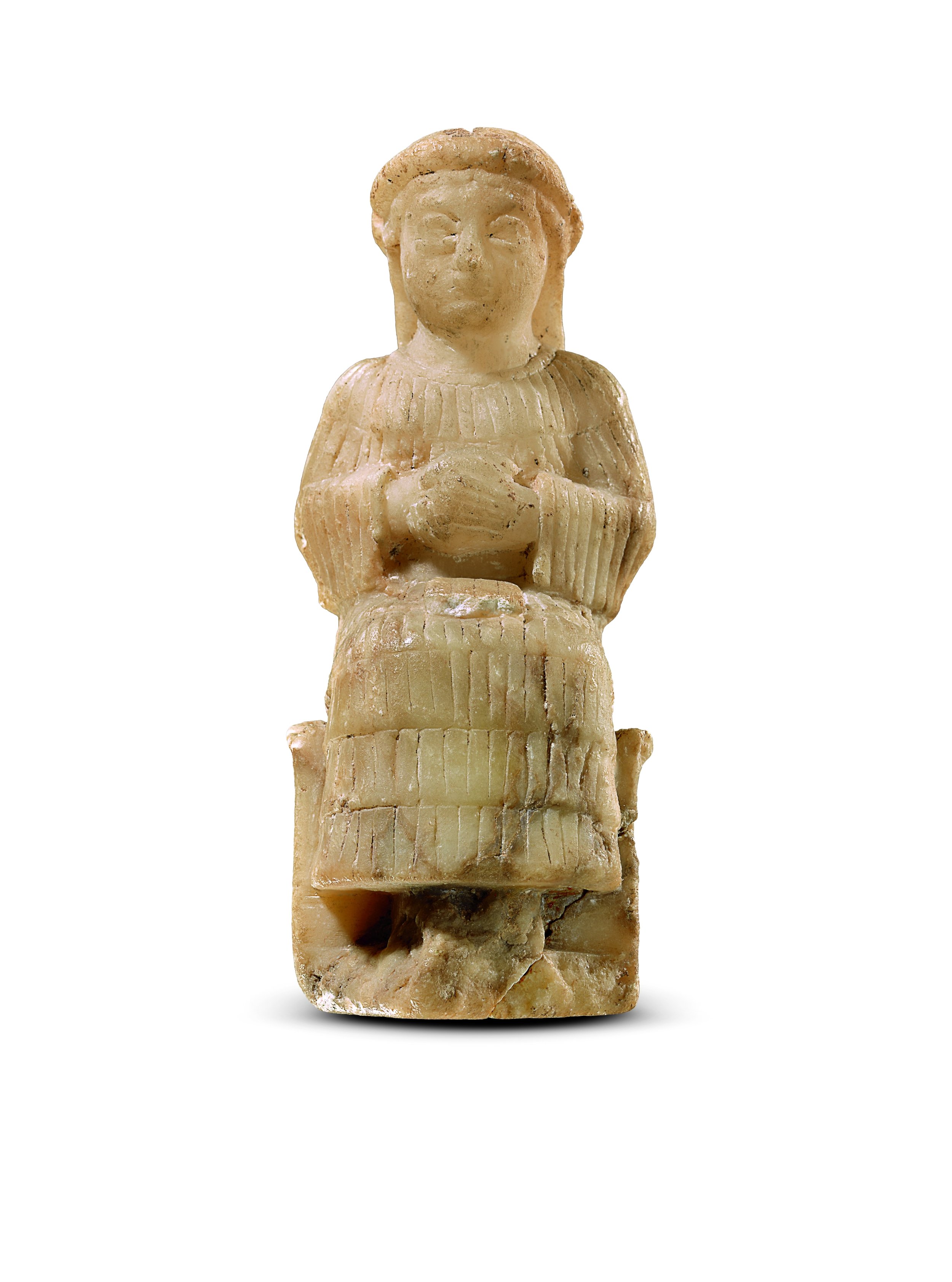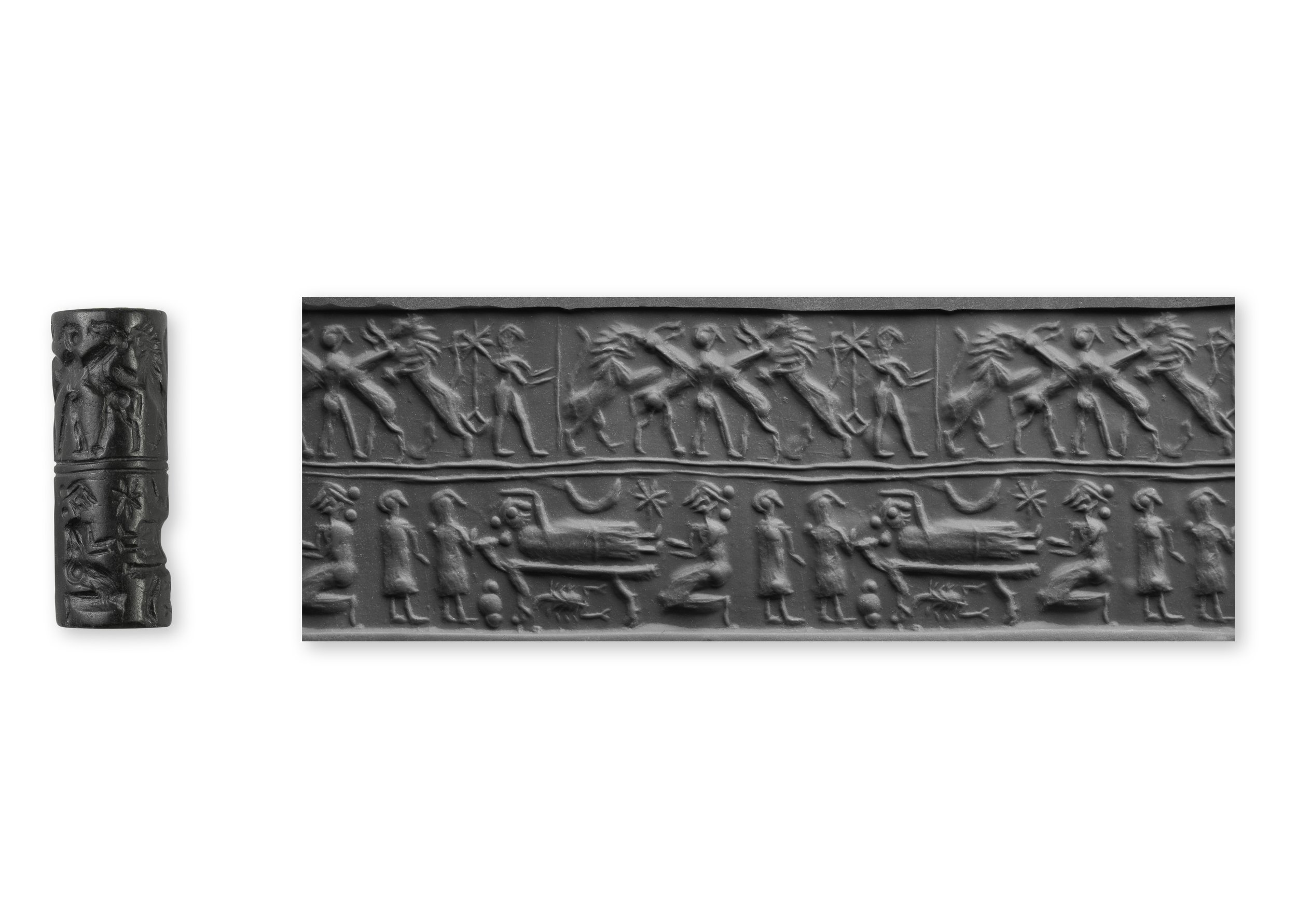
AT A MOMENT when it is difficult to imagine human existence fifty years from now, it can be an enormous pleasure, even a revelation, to step back five thousand years ago or so to contemplate the period when written language began. She Who Wrote: Enheduanna and Women of Mesopotamia, ca. 3400–2000 B.C., a compact but far-ranging exhibit at the Morgan Library and Museum with objects drawn from nine major museums, showcases the role of women in material and written culture in Mesopotamia, a network of flourishing city-states in what is now largely southern Iraq. Organized by longtime Morgan curator of ancient Western Asian seals and tablets Sydney Babcock with Erhan Tamur, a Mellon Fellow at the Metropolitan Museum of Art, She Who Wrote offers even the most casual viewer an accessible but unusual depth of scholarship. Perhaps because of private rather than corporate sponsorship, this exhibit builds a passionate—indeed, often heterodox—argument that women were at the vibrant center of Sumerian and Akkadian life religiously, economically, and culturally.
The foremost innovation of the era, written language, came into use around 3400 B.C., created as stylus was pressed into clay tablets, first as pictographs and later as a more abstract script. Developed first for practical purposes—accounting, property records, legal documents—cuneiform also became a medium for expression, and not just for men. The objects presented in this exhibit demonstrate that women in Mesopotamia wrote as scribes, administrators, and authors. In fact, this exhibit argues that the first identified writer in history was Enheduanna (2300 B.C.), a priestess of rare power and talent, whose writing has nonetheless been largely ignored within the hundred years since it has been excavated.
Ushering us into the exhibit and buttressing its argument is a collection of individual statues of women, each displayed in the round so that her intricate hairstyle and voluptuously detailed dress can be seen in its entirety, as well as her idiosyncratic, if sometimes now-damaged face. How dignified these figures are: hands clasped, backs broad, elaborately scalloped robes as intricate as flowers, faces animated in the superbly arranged lighting, half smiles seeming to flicker. These women are neither nubile nor idealized; indeed, their bodies are squat, their faces dumpling-like, their noses endearingly large, their eyes—once painted or filled in with stones, bitumen, or shells—enormous and deep-set. Whatever their shared characteristics, these sculptures were commissioned for temples by individuals, not always rich or powerful, and are clearly portraits of actual women.
The surrounding walls showcase a wealth of artifacts, many of which, as curator Sydney Babcock notes, are unfortunately not often exhibited as art: vases, bowls, tools, steles, wall plaques, disks, tablets. Each object provides a glimpse into a lost world, and each is also an aesthetic wonder unto itself, carefully placed and accompanied by substantive text. Perhaps the most striking are the cylinder seals, the focus of Babcock’s scholarship. Originating before cuneiform and intertwined with its development, the seals are small tubes made of hard, sometimes precious, stones and engraved with images and written characters. Often used as a signature, a seal was designed to be rolled across wet clay to produce an image in relief. Here, the curators themselves have rolled pristine clay impressions as well as produced enlarged photographs of them, allowing us an unusual intimacy with these visually dense and sophisticated images, many as lively and intriguing as comic strips.

Courtesy of the Oriental Institute of the University of Chicago.
This wonder of objects, spanning a period of more than 1,400 years, shows us women—mortals, priestesses, goddesses—in action. They process dairy products and weave textiles; they offer libations and they accept them, too, sometimes from naked male worshippers; they wave wheat sheaves and date fronds; they quell lions and marauding men; in one seal, a woman cares for a child. The source of all fecundity, agricultural and human, these varied female figures seem self-possessed enough to be feared, revered, and recognized as participants, workers, and legal representatives within their communities; their domesticity goes largely unremarked. Perhaps even more arresting to the modern eye is the way they seem neither contained nor shamed in these representations.
The astonishing “cylinder seal with birth scene” (Sumerian Early Dynastic III Period, ca. 2600–2350 B.C.) depicts a phenomenon nearly unrecorded in Western art. In the bottom register, a woman labors to give birth. Two attendants stand at her head while a midwife prepares to catch the child. Beneath the birthing bed lurks an arachnid—a scorpion, perhaps. But the seal is split into two scenes: above the childbirth tableau, a second register depicts a naked man subduing several lions who threaten four-legged creatures who are neither fully animal nor human. These two graphic narratives don’t intersect, nor does one seem more heavily weighted, except for the looming presence of the midwife, larger than any other creature in the seal. In each register, there is incipient violence: one leading to suffering but life, the other to suffering and death for at least one creature. If it is extraordinary for a man to slay a lion, it is routine for a woman to give birth. Perhaps this seal then emphasizes the ordinary heroism of laboring women and all who attend them. Both men and women live under Inanna, goddess of both fertility and war, her symbolic star appearing in both registers, and seem perhaps united by doing so. While acknowledging the obscurity of the iconography, we at least can see that childbirth, which will become sequestered, unseen, and shameful in Western culture, is celebrated and even heroized here.
If a blank slate in a woman’s hands must remain blank, then an obliterating narrative has been created.
The most visually spectacular item in the exhibit is the funerary ensemble of Queen Puabi (Early Dynastic IIIa Period, ca. 2500 B.C.), a confection of beaten-gold headdress, enormous gold hoop earrings, and cloak made of strings of precious beads. I was surprised to see in my visits to the gallery that this monumental example of bling attracted neither crowds nor even heightened attention. Such is the strength of the exhibit; the less flashy objects are equally, if not more, compelling. Within the argument that the Morgan’s exhibit expertly constructs is the significant fact that Queen Puabi was buried without reference to another male power, suggesting that she may have ruled in her own right, in this case with unimaginable riches. Her own no doubt deadly power extended into the afterlife, as the remains of two other women are buried beside her, ready to serve her forever.
BEYOND THE ILLUSTRATION of women’s power in Mesopotamia, this exhibit posits that the first identified writer in history was a woman. Enheduanna (born ca. 2300 B.C.), daughter of the Akkadian ruler Sargon and appointed by him as a high priestess, took on the mission of uniting the religion of the Akkadian conquerors with that of their Sumerian subjects. Essential to this project was Enheduanna’s written work: her many devotional hymns, including those to the goddess of love, Inanna, and her highly personal description of her own struggles to hold onto power. Enheduanna wrote more than a thousand years after cuneiform’s inception. Her verse was copied by scribes for five hundred years or so after her death. And yet her existence and verse were largely unknown until the excavation of Ur by the British archaeologists Leonard and Katherine Woolley, beginning in 1922. An alabaster obelisk (which appears in the Morgan exhibit) with Enheduanna’s image and written name made a positive identification. Even so, no scholarly article appeared about her until 1958, and no full English translation of her verse was made for yet another decade. The Morgan’s situating of her within the larger reality of women’s power and literacy allows for full appreciation of her work, as well as appreciation for the many women who wrote as priestesses, scribes, legal or family representatives, and perhaps authors.
The Morgan exhibit presents an extraordinary but not unusual example of a woman writing: “seated female figure with tablet on lap” (Neo-Sumerian Ur III period, ca. 2112–2004 B.C). This beguiling alabaster woman—hands clasped in devotion, hair and dress delineated in rhythmic lines, face remarkably beatific—sits with a blank clay tablet on her lap, suggesting a space hers and hers alone to occupy. She is preparing herself to write. At least three similar statues exist in the record, and, upon viewing one, the German scholar Otto Weber wrote, “Our specimen carries a tablet on her knees. Its meaning is not clear to me.” Weber’s resistance to interpretation turns the tablet into meaningless prop but also insists that the woman’s contemplative or expectant expression must instead be one of vacancy. This is particularly striking, as ample evidence suggests that women used cuneiform from its earliest development, both as scribes and as writers in their own right. As Kutay Şen reminds us in his catalog essay, these significant statues of women with tablets have rarely been written about by academics—and only glancingly—during the hundred years since their excavation and eventual placement in the great museums. If a blank slate in a woman’s hands must remain blank, then an obliterating narrative has been created. This narrative is Western, male, and class-bound and, to this day, rigorously defended by many in the academy.
When asked if the seated female figure is a depiction of Enheduanna, Sydney Babcock demurs, but it certainly seems possible. Within this exhibit, Enheduanna herself is anything but a void. The rust-colored earthen tablets with their maze of symbols remind us of how difficult it can be to enter into the past, and how dependent we are on the vagaries of context, attribution, and translation as we do so. The entirety of the exhibit, though, ensures that Enheduanna’s words leap out and grab us:
I was high priestess, I,
Enheduanna.
Though I bore the offering
Basket, though I chanted the
Hymns.
A death offering was ready, was
I no longer living?…
A slobbered hand was laid
Across my honeyed mouth,
What was fairest in my nature
Was turned to dirt.
These words, from The Exaltation of Inanna (translated by Benjamin R. Foster), seem all too familiar: the crying out of a woman adjacent to power but not assured of it, vulnerable to not only mortal danger but also spiritual harm, knowing that her ultimate worth is her ability to convince us of her dilemma. Here, in an account whose first-person voice challenges our understanding of the period’s literary conventions, she tells the story of the usurper who sexually assaults her, urges her to commit suicide, and throws her out of power. It’s a harrowing story, but there is little doubt that its artistry is the reason it was copied by apprentice scribes for centuries. Ultimately, as she recounts, Enheduanna is rescued from her exile by the goddess Inanna and restored to the temple. But it is Enheduanna’s highly personal language that connects her world to ours, language that seems difficult to attribute to anyone but the sufferer of the ordeal.
The cumulative whole of these artifacts is a fleshing-out of what the scholar Zainab Bahrani terms the historical trace of “the hidden woman” in a record that largely has been excavated, archived, and written by Western men. In her essay for the exhibit’s incisive catalog, Bahrani laments what she sees as an erosion of “both feminist work in the field of Western Asian history and women’s rights and attitudes toward women in US history” in the past twenty years. This exhibit provides a powerful corrective. As is so often true in history, what is hidden is in plain sight. The Morgan’s exhibit gives us an opportunity to see what is actually in front of us.
ON VIEW OCTOBER 14, 2022 THROUGH FEBRUARY 19, 2023

